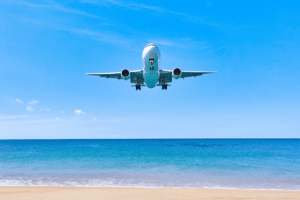Many offshore facilities operate hundreds of miles from the nearest land and require the services of helicopters or seaplanes to bring in new personnel or supplies, or to evacuate a sick or injured worker. Tragically, many helicopters and amphibian planes have crashed into the sea while carrying out these support flights, resulting in a large number of injuries and deaths. Though some of these accidents in navigable waters are caused by bad luck, many maritime aviation accidents involving helicopters, amphibians, and in some cases, commercial airliners are the result of carelessness, incapacity, or neglect on the part of an aircraft’s owner, pilot, or crew member.

Point of No Return: Maritime Aviation Crashes
Although overwater flights are routine events, they are not without risk. Aircraft of all types must always be operated with care and attention to maintenance and safety procedures, Flight is statistically safer than other forms of transportation, but it is less forgiving of neglect, incompetence, or carelessness. If a mechanic forgets to fix a leaky hydraulic line or if a pilot fails to correct a navigational error, the results are often disastrous.
Rotary-wing (helicopter) and fixed-wing aircraft crashes at sea are not uncommon. In 2009, two airliners crashed in ocean waters within weeks of each other. On June 1, Air France Flight 447, an Airbus 330 en route to Paris, France from Rio de Janeiro, Brazil, crashed into the Atlantic Ocean. The two pilots, who were not properly trained on manual flight procedures, lost control of the plane when it flew into bad weather off the coast of South America. 228 people died. On June 30, a Yemeni Airbus 310 crashed in the Indian Ocean off the Comoros Islands. Only one of the 153 passengers and crew aboard survived.
Although airliner crashes tend to grab public attention because of the high casualty counts, they are rarer than crashes involving smaller aircraft involved in offshore industry support roles. In the Gulf of Mexico alone, more than 40 helicopters have crashed on their way to or from oil rigs, drilling vessels, or natural gas facilities since 2000.
In January of 2009, a Sikorsky S-76 owned by PHI Inc. of Houston, crashed in the Gulf of Mexico near Morgan City, Louisiana as it carried several workers to an offshore oil rig. Eight persons died and one was injured. Four years later, in October of 2013, a helicopter pilot was killed and two oil workers were hurt when the aircraft fell into the Gulf crashed shortly after taking off from an oil rig near Venice, Louisiana. Other incidents involving helicopter accidents in the Gulf of Mexico include the crash of a Bell 206 near Sabine Pass in December of 2008. The helicopter was carrying four oil workers to an offshore rig. Per the NTSB investigation of the crash which killed all five aboard, poor visibility and a pilot who was not certified in instrument flying were the probable causes.
Common Injuries in Maritime Aviation Accidents
Aviation accidents at sea can cause severe injuries to passengers and crew. Unless a pilot can manage to make a soft, controlled landing on a body of water, most aircraft break apart upon impact with the water, especially if they are traveling fast and out of control. The fuel in the tanks can explode, and the torn metal of the aircraft’s fuselage can cause penetrating wounds, cuts, and amputated limbs. The most common cause of injury in an aircraft crash at sea is the sudden deceleration that occurs when a plane or helicopter makes an impact on water. As a result of sudden deceleration, head injuries are the most common in aircraft accidents.
Other common injuries caused by aircraft accidents at sea include:
- Spinal injuries
- Pelvic fractures
- Thoracic injuries
- Abdominal injuries
- Leg and arm fractures
- Burns
- Hypothermia
Why the Jones Act Applies to Certain Aviation Accidents at Sea
The U.S. maritime law known as the Merchant Marine Act of 1920 or Jones Act provides compensation to seamen if they are injured while at work on the high seas. The assumption is that it only applies to workers on ships or other vessels, but the Jones Act’s loose definition of who a “seaman” is allows certain aviation employees to qualify for compensation.
If a helicopter or seaplane is owned or leased by a company which operates oil rigs or other facilities at sea, it usually does the same jobs as ferries, supply boats, or other support vessels employed to service offshore facilities. As a result, aviators hired by energy production companies to fly air taxi and medical evacuation missions are considered seamen in Jones Act-related issues.
Similarly, some airline crashes that occur on the high seas are covered by both the Jones Act and the Death on the High Seas Act (DOHSA). Even if aircrew for airliners are not literally seamen, they are performing the same tasks as an ocean liner’s crew, only on an aircraft. General maritime law, DOHSA, and the Jones Act permit allow claims to be filed against third parties if the accident was a result of negligence, carelessness, or incompetence by a pilot, the airline, or a crew member.
Sources:
- http://metro.co.uk/2014/01/11/new-zealand-aeroplane-crashes-into-sea-beach-4258418/
- http://www.bbc.co.uk/news/world-10785301
- http://www.nola.com/traffic/index.ssf/2013/10/pilot_killed_in_helicopter_cra.html
- http://www.beaumontenterprise.com/news/article/NTSB-reports-likely-cause-of-Sabine-Pass-729535.php